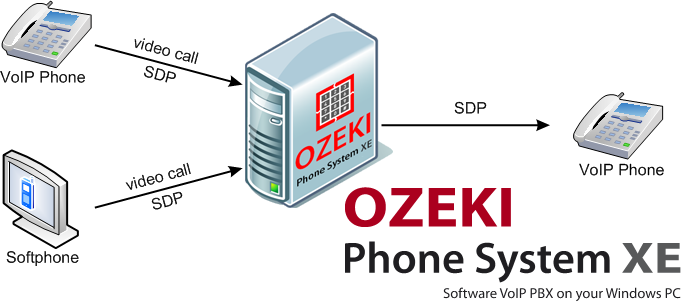What is SDP (Session Description Protocol)?
In this article you can read about Session Description Protocol that is used between two networks for communication. If you are interested in this topic you can find more information and a video in the sections below.
SDP transports information on media streams, in multimedia sessions (exists for a certain duration of time) that includes e.g. session announcement and session invitation. It allows recipients to take part in SD (Session Description). It is primarily applied in inter-networks and also applied for describing conferences. The Session Description protocol does not send data itself, it is only used for the communication between end-points. In the picture below you can see that a VoIP phone and a softphone calls another VoIP phone that is transmitted by Ozeki Phone System and the call goes through an SDP channel (Figure 1).

Two Main Purposes of SDP
- communication during a session (session includes a sender, a receiver, and media stream)
- transporting information to enable participation
SDP Message Has 3 Main Parts
- session detailing (aim and name of session)
- time (when it is active)
- media
SDP messages contain several different sessions, time and media descriptions.
Session description values:
- v=(protocol version)
- o=(originator and session identifier)
- s=(session name)
- i=*(session information)
- e=*(email address)
- p=*(phone number)
Time Description
- t= (time when the session is active)
- r=* (zero or more repeat times)
Media Description
- m=(media name and transport address)
- c=*(connection information - optional if included at session-level)
- a=*(zero or more media attribute lines)
(* signs optional values)
Private Sessions
With the help of a Session Description Protocol, you are able to make public and private sessions too. If you want to make a session private, you have to encrypt it.
The Session Description Protocol is supported by the Ozeki Phone System and it uses SDP in communication. Ozeki Phone System is an outstanding PBX telephone system that uses SDP to get information on data.
Read the following pages for more SDP related topics:
More information
- What is VoIP (Voice over Internet Protocol)?
- What is SIP (Session Initiation Protocol)?
- What is PABX (Private Automated Branch Exchange)?
- What is IP PBX? (Internet Protocol Private Branch Exchange)
- What is VoIP PBX (Voice Over Internet Protocol Private Branch Exchange)?
- What is SIP Trunking (Session Initiation Protocol Trunking)?
- What is SIP Trunk (Session Initiation Protocol Trunk)?
- What is Direct Dial In: DID?
- What is IVR (Interactive Voice Response)?
- What is RTP (Real-time Transport Protocol)?
- What is RTCP (Real-time Transport Control Protocol)?
- What is SRTP?
- What is H323?
- What is VoIP Tunnel?
- What is PSTN Gateway?
- What is CAPI?
- What is FXO?
- What is FXS?
- What is PRI/E1?
- What is PRI/T1?
- What is PRI/J1?
- What is PRI?
- What is ISDN NT?
- What is ISDN TE?
- What is VoIP Client (Voice Over Internet Protocol Client)?
- What is SIP Client?
- What is SIP Server?
- What is VoIP Server (Voice Over Internet Protocol Server)?
- What is Dial Plan?
- What is Asterisk?
- What is VLAN?
- What is VoIP Phone?
- What is SIP Phone?
- What is IP Phone?
- What is SIP Account?
- What is ATA?
- What is Ring Group?
- What is Virtual PBX?
- What is Hosted PBX?
- What is PSTN?
- What is SDP (Session Description Protocol)?
- What is DECT?
- What is VoIP Call?
- What Is VoIP Cluster?
- What is Trunk?
- What is Fring?

 Sign in
Sign in